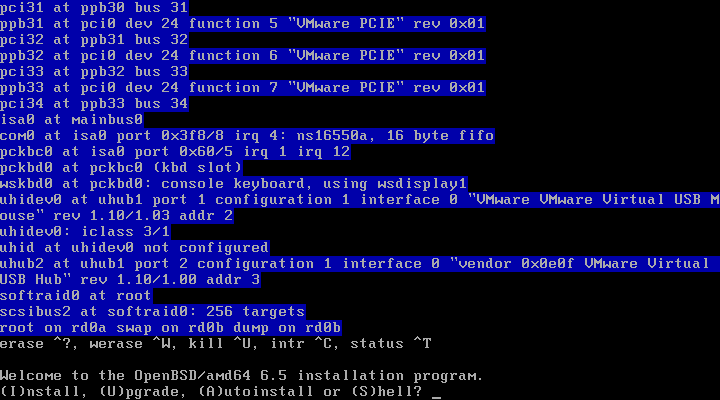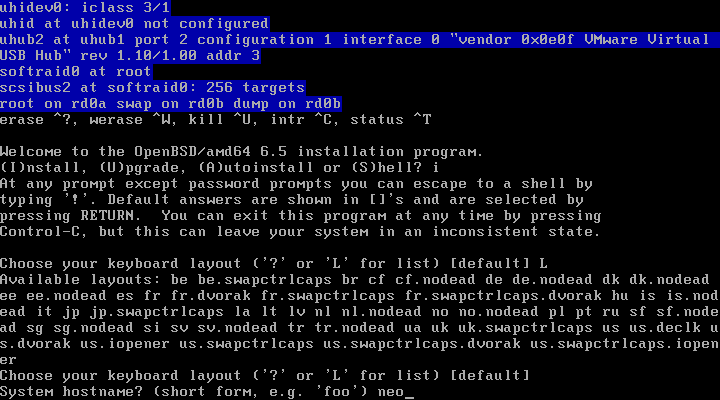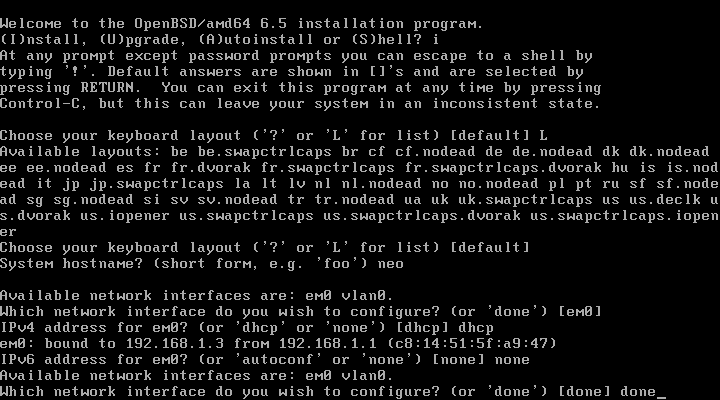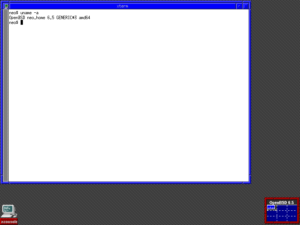I am installing OpenBSD in VMware to test out this very nice UNIX operating system, and this should be very easy to do.

I chose to install manually, the auto installation option does not work.

Then I had to setup the network interfaces for the operating system. I chose to use DHCP for the Ethernet interface and not bother with a IPv6 address, this is not needed for my requirements.

After this it is pretty easy to install, when the partitioning is done, I chose to just use the whole disk as a GPT partition and auto partition it. Then install the base system to make a bootable operating system. When asked for a package mirror hostname, type ftp.openbsd.org. Then it will automatically add the path to the packages. Just press ENTER to add this information. Once everything is installed, reboot and then you can log in and use your new OpenBSD system.

The default desktop interface is very ugly, but usable. If you enabled SSH, then you may login over SSH and then manage your new system. There are multiple desktops that may be switched using the pager, and applications can be minimized to save desktop space.
OpenBSD 6.5 (GENERIC) #3: Sat Apr 13 14:42:43 MDT 2019 Welcome to OpenBSD: The proactively secure Unix-like operating system. Please use the sendbug(1) utility to report bugs in the system. Before reporting a bug, please try to reproduce it with the latest version of the code. With bug reports, please try to ensure that enough information to reproduce the problem is enclosed, and if a known fix for it exists, include that as well. neo$ |
Use the pkg_add command to install software if required. Not all is available on OpenBSD. Some packages are outdated and insecure.
neo# pkg_add rxvt quirks-3.124 signed on 2019-04-15T12:10:16Z quirks-3.124: ok Can't find rxvt Obsolete package: rxvt (no longer maintained and full of security holes) |
But other ones like Midnight Commander are still available.
neo# pkg_add mc quirks-3.124 signed on 2019-04-15T12:10:16Z mc-4.8.22p0:pcre-8.41p2: ok mc-4.8.22p0:bzip2-1.0.6p9: ok mc-4.8.22p0:xz-5.2.4: ok mc-4.8.22p0:sqlite3-3.27.2p0: ok mc-4.8.22p0:libiconv-1.14p3: ok mc-4.8.22p0:gettext-0.19.8.1p3: ok mc-4.8.22p0:libffi-3.2.1p5: ok mc-4.8.22p0:python-3.6.8p0: ok mc-4.8.22p0:glib2-2.58.3p8: ok mc-4.8.22p0:png-1.6.35: ok mc-4.8.22p0:oniguruma-6.9.1: ok mc-4.8.22p0:libslang-2.2.4p4: ok mc-4.8.22p0:libssh2-1.8.2: ok mc-4.8.22p0:unzip-6.0p11: ok mc-4.8.22p0:zip-3.0p1: ok mc-4.8.22p0:libsigsegv-2.12: ok mc-4.8.22p0:gdiff-3.7: ok mc-4.8.22p0: ok Running tags: ok New and changed readme(s): /usr/local/share/doc/pkg-readmes/glib2 |
The pkg_info command is good for finding out information about packages.
neo# pkg_info -Q xterm ajaxterm-0.10p12 roxterm-2.9.7p3 xtermset-0.5.2p2 |
Update an installed package with the pkg_add -u PACKAGENAME command like this.
neo# pkg_add -u mc quirks-3.124 signed on 2019-04-15T12:10:16Z |
Firefox 66 is available for OpenBSD, type pkg_add firefox to install.
This operating system can be a viable desktop OS, but works best as a server operating system. Way more security and reliability than Windows 10 and Windows Server. Windows 10 is notorious for updates breaking the whole system. That is not the hallmark of a quality operating system. You should have a separate DEV build for select testers, do not use your customers as free testers for your crappy OS. Put more effort into the development and testing in-house and you will have a more secure and reliable desktop OS. That is why I will not use Windows 10. The telemetry is just abominable.
To set a custom screen resolution in OpenBSD in VMware, run the xrandr command to list all resolutions available on your system.
Screen 0: minimum 320 x 200, current 1152 x 864, maximum 1176 x 885 default connected 1152x864+0+0 0mm x 0mm 800x600 60.00 85.00 75.00 72.00 56.00 0.00 1152x864 75.00* 0.00 1024x768 85.00 75.00 70.00 60.00 0.00 1024x576 60.00 832x624 75.00 960x540 60.00 864x486 60.00 640x480 85.00 75.00 73.00 60.00 0.00 720x405 60.00 720x400 85.00 640x400 85.00 0.00 640x360 60.00 59.00 640x350 85.00 320x240 0.00 400x300 0.00 512x384 0.00 854x480 0.00 720x480 0.00 720x576 0.00 320x200 0.00 800x480 0.00 1176x885 0.00 |
Then use this command to set the desired resolution.
neo$ xrandr -s "1152x864 75.00 0.00" |
This is quite simple, this is the best way to install a very nice and very secure operating system based on UNIX. The default desktop is very clunky, but you can install others.